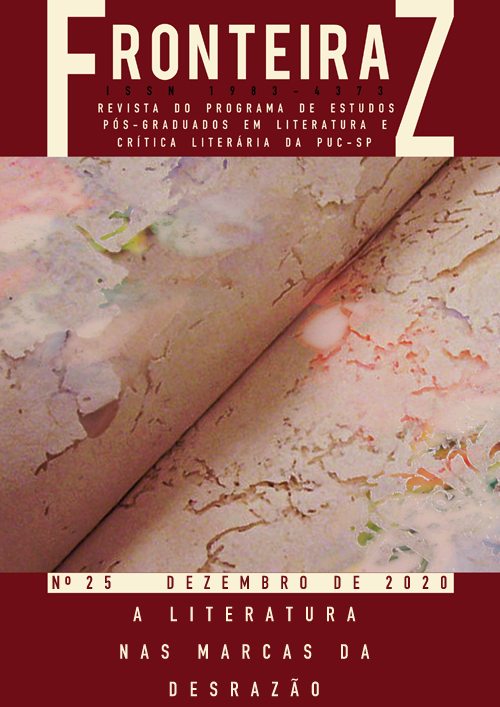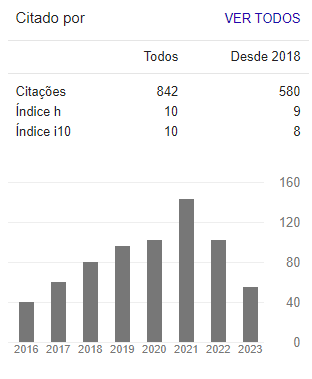O bordado no livro infantil
questões de materialidade e intermidialidade
DOI:
https://doi.org/10.23925/1983-4373.2020i25p169-183Palavras-chave:
Intermidialidade, bordado, arte têxtil, literatura infantilResumo
O bordado tem sido usado para ilustrar livros infantis como reflexo de uma produção artística contemporânea que tem lançado mão de diversas iniciativas que destacam e reavaliam o papel das artes têxteis nas produções visuais. Objetiva-se com este artigo examinar o uso da materialidade do bordado livre nas ilustrações de algumas obras de literatura para crianças, tais como Menino do Rio Doce (1996), Ponto a ponto (2006), A menina que falava bordado (2010), Este não é um livro de princesas (2014) e Os bordados da vovó (2017). Como metodologia de análise, as obras serão examinadas segundo a intermidialidade de Claus Clüver (2011) e Irina Rajewsky (2012). Por fim, busca-se fomentar discussões a respeito da contribuição de técnicas artesanais de ilustração, como o bordado livre, para os estudos das relações imagem e palavra das publicações voltadas para crianças.Referências
BARRETT, A. A Stitch in Time: New Embroidery, Old Fabric, Changing Values. Textile Society of America Symposium Proceedings. 79, 2008. Disponível em: https://digitalcommons.unl.edu/tsaconf/79 . Acesso em: 15 out. 2019.
CLÜVER, C. Intermidialidade. Pós – Revista do Programa de Pós-graduação em Artes – EBA/UFMG, v. 1, n. 2, p. 8-23, 2011.
DELAGE, R. Cada mulher borda sua própria vida. Tribuna de Minas. Cultura. 07/03/2012. Disponível em: https://tribunademinas.com.br/noticias/cultura/07-03-2012/cada-mulher-borda-sua-propria-vida.html. Acesso em: 21 ago. 2020.
DINIZ, T. F. N. Intermidialidade e estudos interartes: desafios da arte contemporânea. Belo Horizonte: Editora da UFMG, 2012.
FRANCO, B. A menina que falava bordado. Ilustrações de José Carlos Lollo. Barueri/SP: Manole, 2010.
FRANCO, B. Este não é um livro de princesas. Ilustrações de José Carlos Lollo. São Paulo: Peirópolis, 2014.
LINDEN, S. V. der. Para ler o livro ilustrado. Trad. Dorothée de Bruchard. São Paulo: Cosac Naify, 2011.
MACHADO, A. M. Ponto a ponto. Ilustrações de Cristina Röhrig. São Paulo: Companhia das Letrinhas, 2006.
MACHADO, A. M. Pontos de fuga: conversas sobre livros. São Paulo: Companhia das Letras, 2016.
PARKER, R. The Subversive Stitch: Embroidery and the Making of the Feminine. New York: Routledge, 1984.
RAJEWSKY, I. O. Intermidialidade, intertextualidade e “remediação”: uma perspectiva literária sobre intermidialidade. Trad. Thaïs Flores Nogueira Diniz e Eliana Lourenço de Lima Reis. In: DINIZ, T. F. N. (Org.). Intermidialidades e estudos interartes: desafios da arte contemporânea. Belo Horizonte: UFMG, 2012.
RIBEIRO, N. Os bordados da vovó. Ilustrações de Ana Sanfelippo. São Paulo: Editora do Brasil, 2017.
TEIXEIRA, S. D. D. A rebelião das raposas. Brasília: Art Dumont, 1991.
ZEPETNEK, S. T.; LÓPEZ-VARELA, A.; SAUSSY, H.; MIESZKOWSKI, J. Introduction to New Perspectives on Material Culture and Intermedial Practice. CLCWeb: Comparative Literature and Culture v. 13.3, 2011. Disponível em: https://doi.org/10.7771/1481-4374.1783. Acesso em 21 ago. 2020.
ZIRALDO. Menino do Rio Doce. Ilustrações de Demóstenes Vargas. São Paulo: Companhia das Letras, 1996.
Downloads
Publicado
Como Citar
Edição
Seção
Licença
Copyright (c) 2020 FronteiraZ. Revista do Programa de Estudos Pós-Graduados em Literatura e Crítica Literária

Este trabalho está licenciado sob uma licença Creative Commons Attribution-NonCommercial 4.0 International License.







 Este obra está licenciada com uma Licença
Este obra está licenciada com uma Licença 